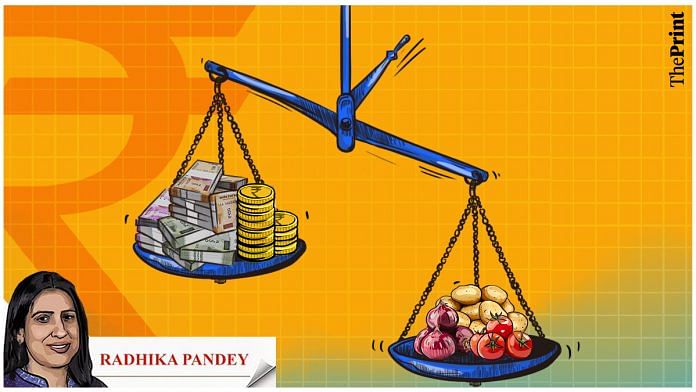India’s retail inflation eased to a 25-month low of 4.25 per cent in May from 4.7 per cent in the previous month. Food and beverages inflation slipped from 4.16 per cent in April to 3.29 per cent in May. Other broad categories also showed a moderation in inflation in May. However, in the last few weeks, the prices of some food articles have soared across various parts of the country.
While these will show up in the Consumer Price Index (CPI) data for June, which will be released on 12 July, it is useful to look at high frequency data to get some early indications of the drivers of spurt in food inflation.
Daily retail food price data
Food constitutes roughly 39 per cent of the overall Consumer Price Index (CPI) in India. Food group in the CPI covers 114 items spread over six sub-groups.
Price Monitoring Division (PMD) in the Department of Consumer Affairs monitors retail and wholesale prices, and spot and future prices of 22 essential commodities on a daily basis. This data is collected from 115 market centres spread across the country.
We exclude “tea” from the analysis as the focus is on the ‘food’ group. This gives us a set of 21 commodities. These 21 items constitute roughly 23 per cent of the overall CPI and nearly 58 per cent of the CPI-food.
The table below shows the distribution of the 21 items across the six sub-groups under CPI-Food. For example, out of 20 items in the category of ‘Cereals and Products’, three items are monitored by the PMD on a daily basis.
While the 20 items have a weight of roughly 10 per cent in the overall CPI, the three items monitored on a daily basis have a weight of almost 7.5 per cent. Thus, in terms of the ‘count’ of commodities, the representation may not be significant, but these 21 items captured on a daily basis do have a significant presence in terms of weight in the CPI-Food.
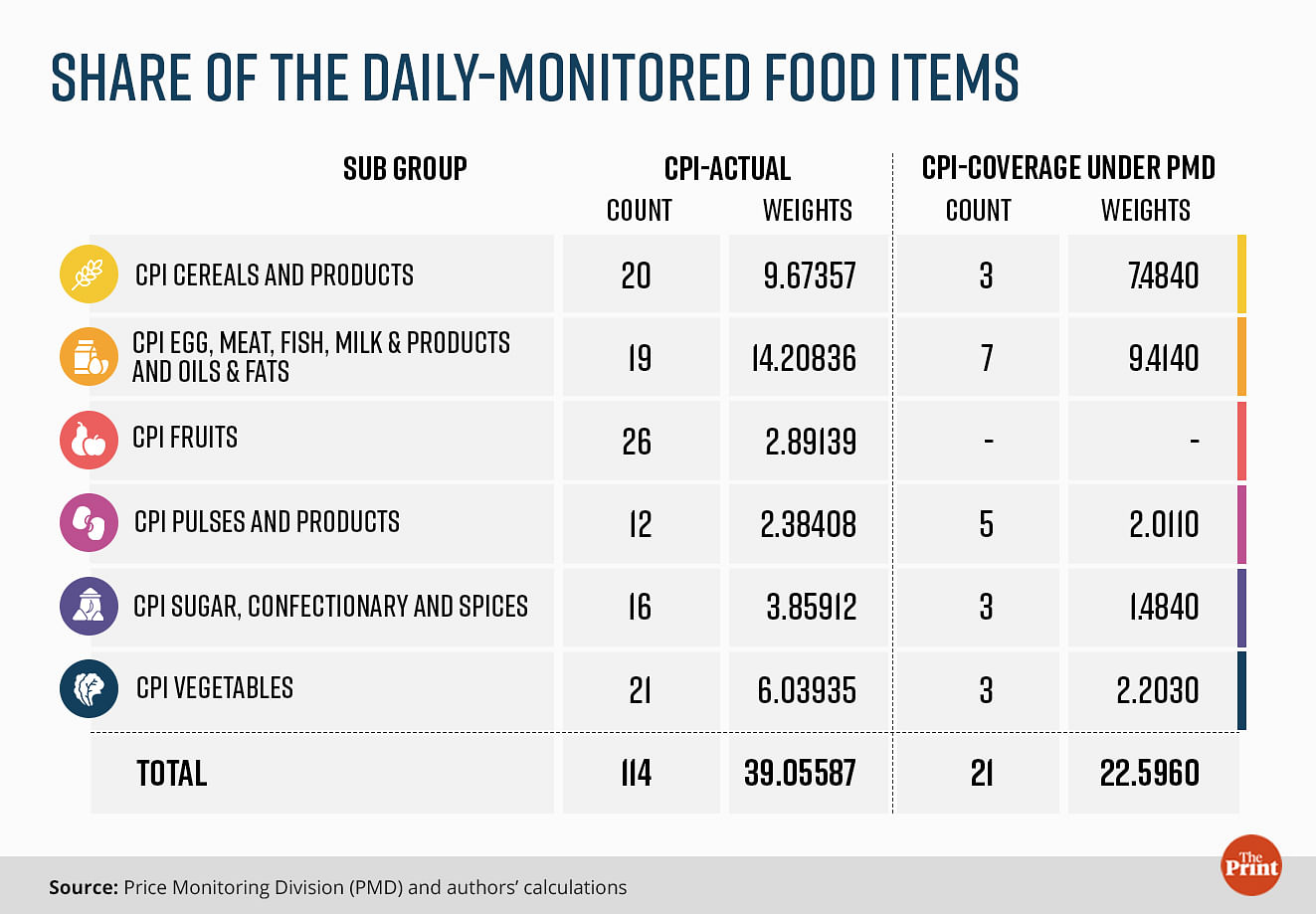
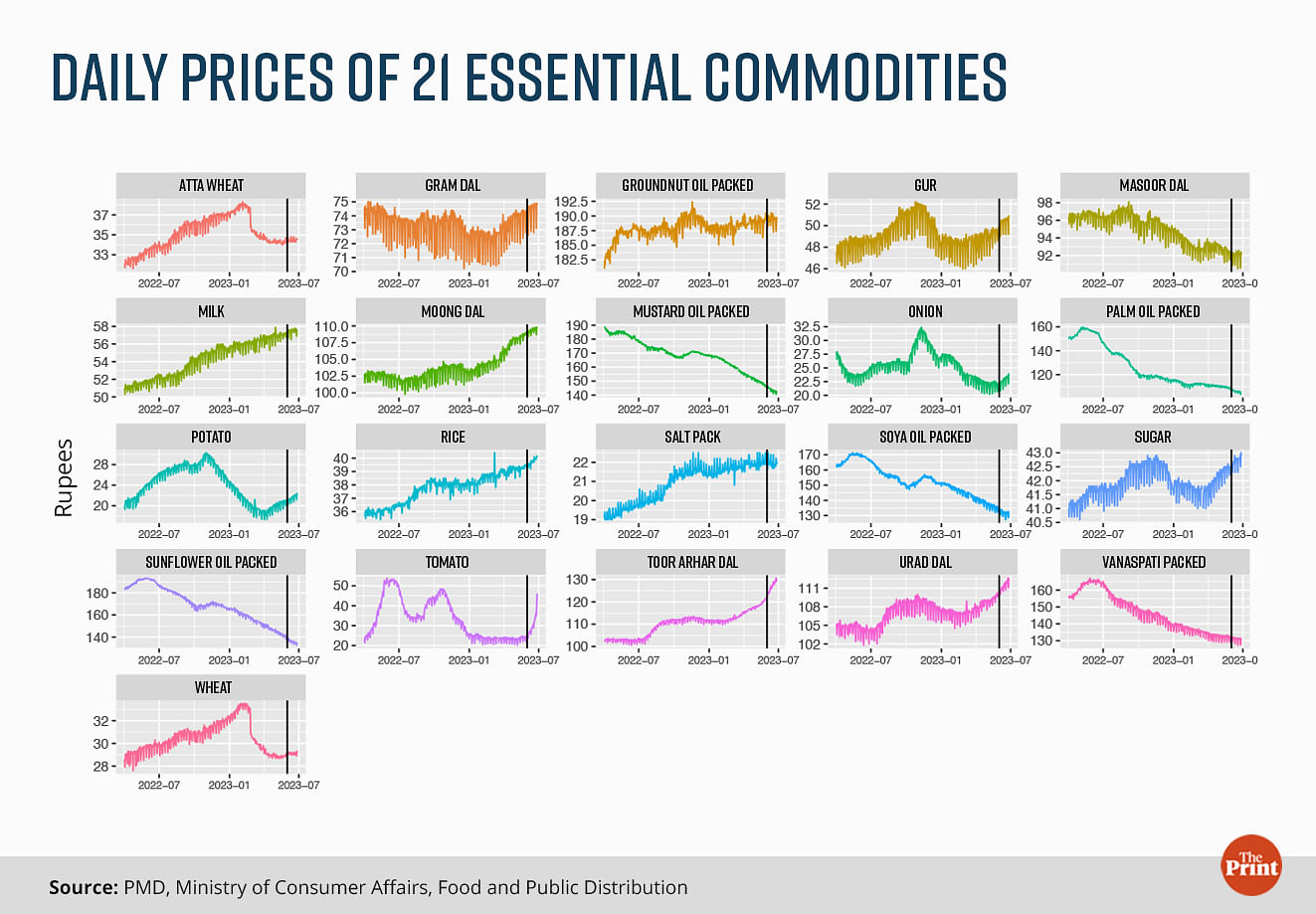
Also read: India-US trade ties deepening, but Modi may need to commit to easing protectionist policies
Prices of tomato, onion and potato rising
The above figure shows the daily prices of these 21 commodities since 1 April, 2022. It shows that tomato prices have soared from Rs 32 per kg on 20 June to Rs 46 per kg on 27 June.
Delayed monsoons and high temperatures have contributed to the significant spike in tomato prices. The unusual heat of March and April saw pest attacks that damaged the crop. In recent few days, heavy rainfall in southern states has impacted the transportation of crops and resulted in damage of this highly perishable commodity. In addition, the sowing of tomatoes has been lower than last year. As the price of other vegetables, such as beans, surged last year, many farmers, particularly in Karnataka, switched to growing beans this year.
Figure shows that prices of onion and potato have also inched up in June, though not at the pace at which tomato prices have seen a spike.
Do tomato prices spike around this time every year?
The figure below shows the retail prices of tomatoes in the past five years. It is difficult to discern a distinct seasonal pattern in prices, but the definite inference is that prices do turn volatile during this period. For instance, in 2022, tomato prices peaked in June and again in October. In 2020, peak was seen in July and September.
The rise in prices in recent days is in the Rabi crop of tomato — which is grown in parts of Maharashtra, Karnataka and Andhra Pradesh. This crop is in the market between March and August. The Kharif crop reaches the market post August. Supply shortages result in phases of spikes in price in different months of the year.
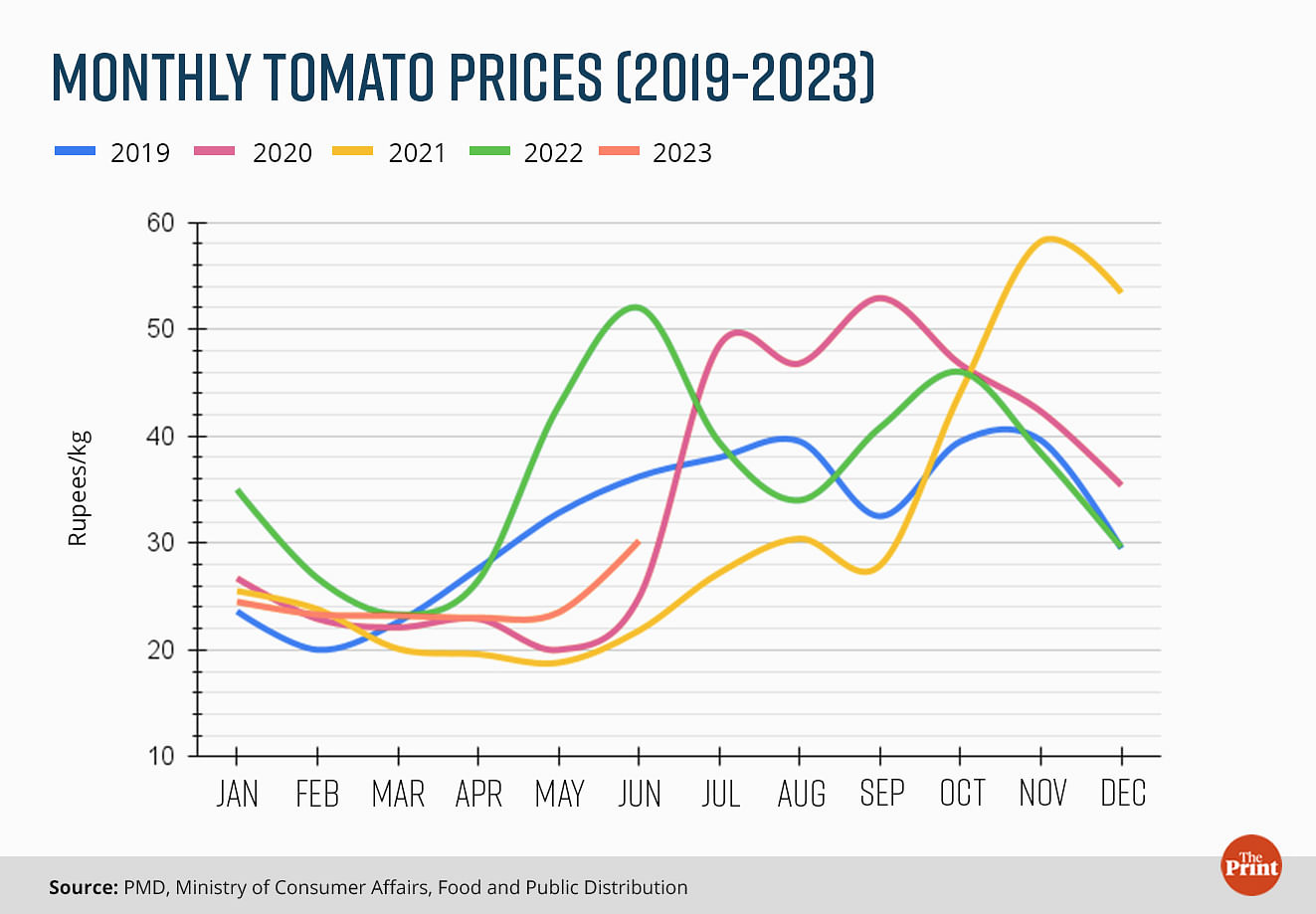
Wholesale prices of tomato up across states
The wholesale arrivals of tomatoes across various markets of states show a broad-based surge in prices. State-wise wholesale monthly price analysis for tomato shows Maharashtra, Telangana, Andhra Pradesh, Karnataka and Gujarat saw the maximum surge in prices from May to June 2023. It is worthwhile to note that prices across all states are still lower than the prices in the corresponding month of last year, implying that prices were elevated in June of last year as well.
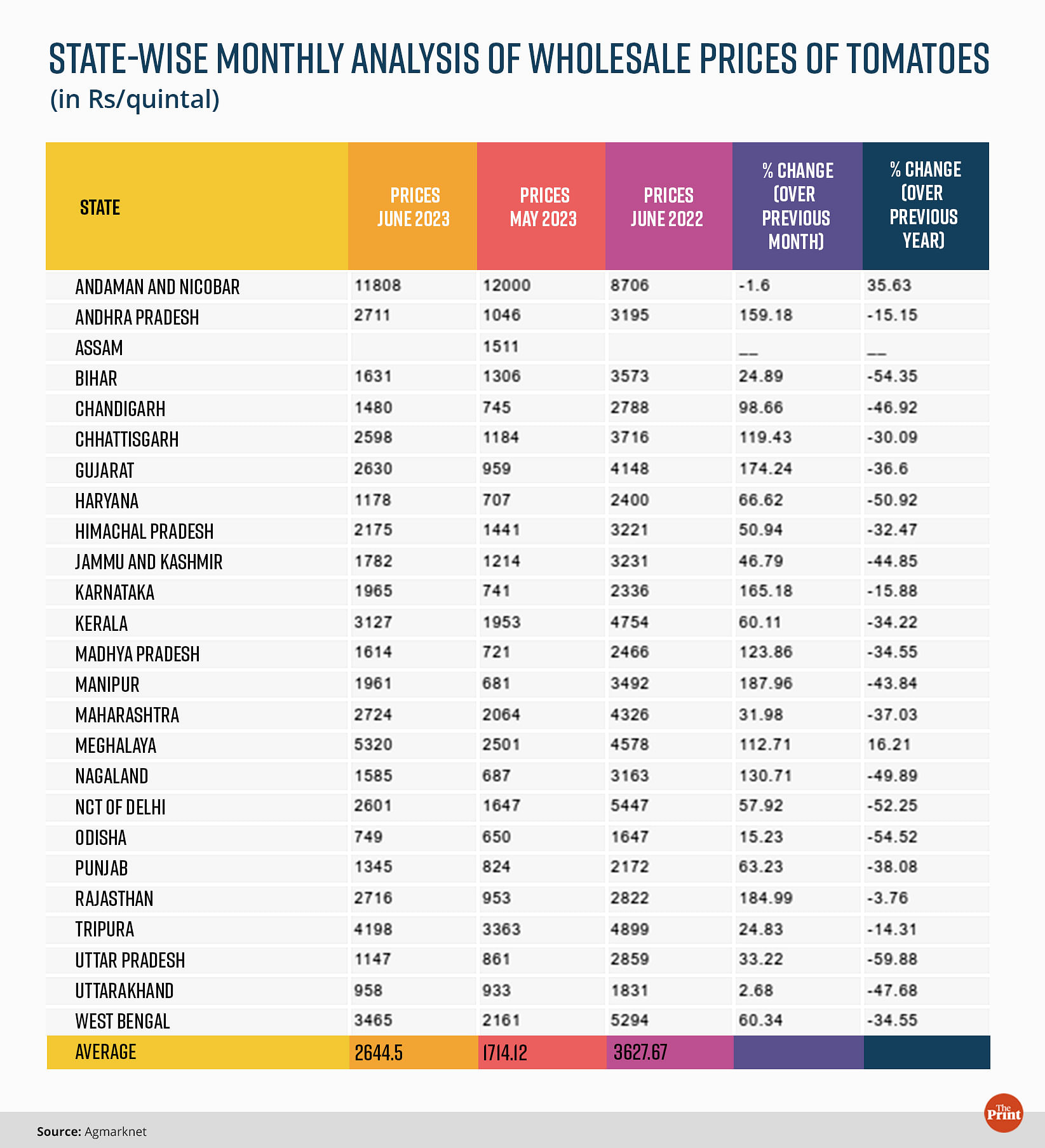
The data is sourced from the Agmarknet portal, which provides static and dynamic information about agricultural marketing in India. While static information includes infrastructure-related information such as storage and market-related information, dynamic information includes price related information of different varieties, total arrivals and dispatches.
Also read: Inflation eased, but here’s why RBI’s unchanged policy repo rate is likely to stay for some time
Elevated prices of pulses
Figure on daily prices of essential commodities from the PMD shows that among pulses, the prices of toor and urad dal have seen a spurt in the recent few months. To cool prices of toor dal, the government has decided to release it from the national buffer till imported stocks arrive in the Indian market. In early June, the government had imposed stock limits on toor and urad by invoking the Essential Commodities Act. The stock positions with stock-holding entities such as wholesalers, retailers and millers are being monitored.
To boost production, the government has removed the procurement ceilings of 40 per cent for toor, urad and masoor under Price Support Scheme (PSS). The move is to motivate farmers to enhance the sowing area under toor and urad by giving assured procurement of these pulses by the government.
Surge in milk prices
Milk prices have been rising at a sustained pace since the beginning of 2023. A major reason has been due to a rise in cost or production. The cost of feed has been rising due to an increase in the price of raw materials such as maize and corn. The rise in cost of production is discouraging farmers from adequately feeding their cattle resulting in lower yields.
Increase in labour cost and cost of transportation has also added to the cost of production. The RBI in its latest monetary policy statement also noted that milk prices are likely to remain under pressure due to supply shortfalls and high fodder costs.
However, other major constituents of food inflation such as oils and fats have seen an easing of prices. Wheat prices have also seen a moderation in recent months. The food inflation trajectory would be shaped by these dynamics and government’s supply interventions in the coming months.
Radhika Pandey is an associate professor and Pramod Sinha is a Fellow at the National Institute of Public Finance and Policy (NIPFP).
Views are personal.
Also read: Fiscal health check — how India’s 4 big poll-bound states stack up


